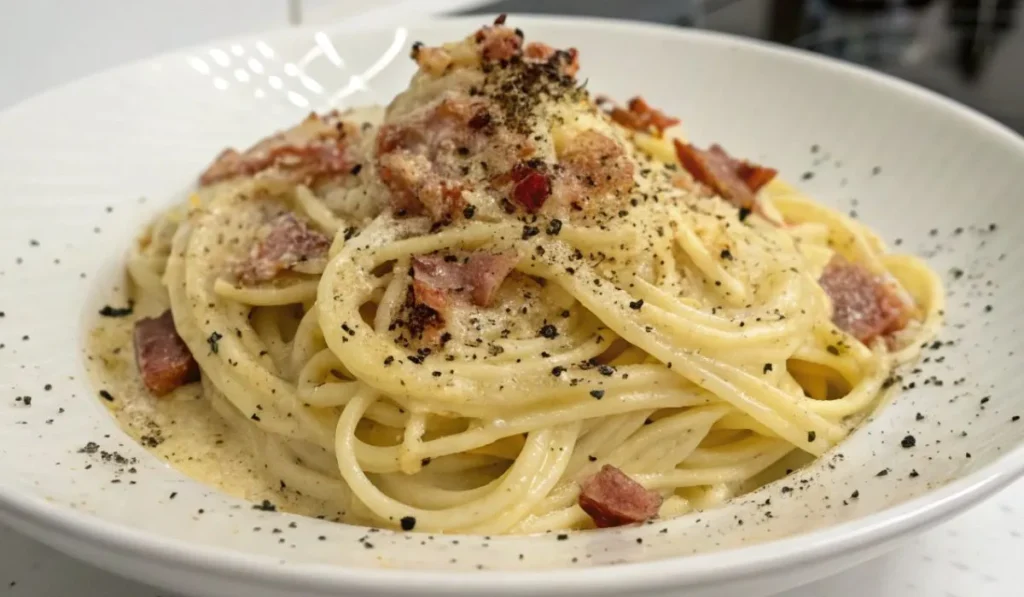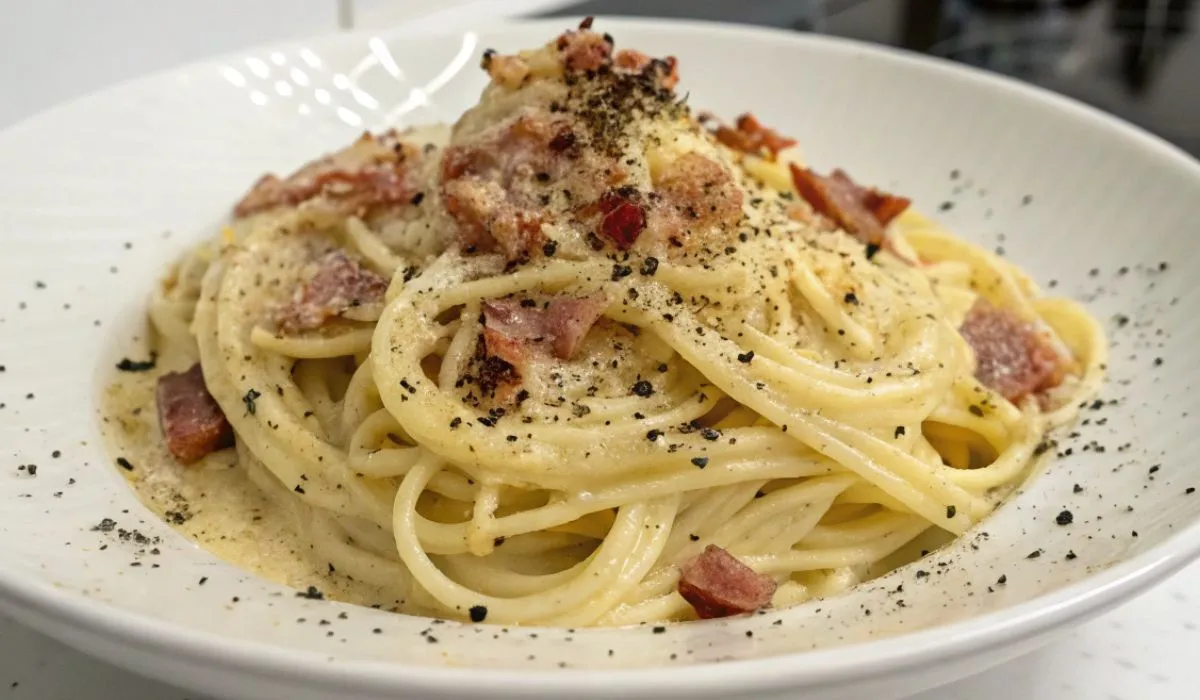This traditional carbonara recipe creates a silky, restaurant-quality pasta dish in just 15 minutes. After making this classic Italian carbonara hundreds of times in my kitchen, I can tell you there’s nothing quite like the magic that happens when hot pasta meets raw eggs and cheese.
Many recipes add cream, but authentic carbonara gets its creamy texture from just four simple ingredients: eggs, cheese, guanciale (or bacon), and pasta water. The result is pure perfection that will make any Italian proud.

Essential Carbonara Ingredients
The beauty of real carbonara lies in its simplicity. You need only a handful of quality ingredients to create this masterpiece:
- Guanciale. This cured pork jowl is the traditional choice, but pancetta or thick-cut bacon work well
- Large eggs. Use 2 whole eggs plus 2 extra yolks for the perfect creamy consistency
- Parmigiano Reggiano. Freshly grated aged parmesan creates the best flavor (avoid pre-grated)
- Spaghetti. Long pasta works best, though any pasta shape will do
- Black pepper. Freshly ground pepper adds the classic bite
- Pasta cooking water. The starchy water helps bind everything together
Pro tip from my experience. Always buy guanciale or bacon in block form so you can cut thick batons. These meaty chunks are what make each bite special.
Step-by-Step Carbonara Instructions
Making authentic carbonara is easier than most people think. Here’s how I’ve perfected the technique over years of cooking:
- Cut guanciale into thick batons (about 1/5 inch thick)
- Whisk eggs and yolks in a large bowl, then mix in grated cheese and black pepper
- Boil 4 quarts of salted water and cook spaghetti until al dente
- Meanwhile, fry guanciale in a pan without oil until golden and crispy
- Reserve 1 cup of pasta cooking water before draining pasta
- Toss hot pasta with the crispy guanciale and its rendered fat
- Transfer everything to the bowl with egg mixture and add 1/2 cup pasta water
- Stir vigorously with a wooden spoon handle for 1 minute until the sauce becomes creamy
Why This Method Works
The secret to perfect carbonara sauce is understanding the science. When you combine hot pasta with raw eggs and starchy pasta water, the proteins in the eggs gently cook and thicken without scrambling. The fat from the guanciale helps create that silky texture everyone loves.
I learned this technique from watching Italian grandmothers cook, and it never fails. The key is working quickly and stirring constantly to prevent the eggs from cooking too fast.
Common Carbonara Mistakes to Avoid
Even experienced cooks can mess up this simple dish. Here are the biggest mistakes I see people make:
- Adding cream (this isn’t traditional and changes the flavor completely)
- Using lean bacon instead of fatty guanciale or thick-cut bacon
- Not reserving enough pasta cooking water
- Letting the pan get too hot and scrambling the eggs
- Using pre-grated cheese that won’t melt properly
- Not serving immediately while the pasta is hot
Expert Tips for Perfect Results
After making this dish countless times, these tricks guarantee success:
- Warm your serving bowls before plating
- Use the wooden spoon handle to stir – it’s faster and more effective
- If the sauce seems too thick, add more pasta water gradually
- If it’s too thin, keep stirring off the heat until it thickens
- Serve immediately – carbonara waits for no one
Food Safety Note: Modern food safety standards make raw eggs from reputable stores safe to eat. However, pregnant women or those with compromised immune systems should avoid raw eggs.
Variations and Substitutions
This recipe works with budget-friendly alternatives too. While purists might object, these swaps still create delicious results:
- Use regular parmesan instead of aged Parmigiano Reggiano
- Substitute thick-cut bacon for guanciale
- Add minced garlic in the last minute of cooking (not traditional but tasty)
- Try pecorino romano cheese for a sharper flavor
Serving and Storage
Carbonara tastes best when served immediately in warm bowls. The creamy sauce stays silky, and the pasta maintains its perfect texture. As it cools, the sauce thickens and the pasta becomes less appealing.
Leftovers keep for up to 3 days in the refrigerator, but reheated carbonara never matches the original experience. This is a dish meant to be enjoyed fresh and hot.
Final Thoughts
This authentic carbonara recipe proves that simple ingredients can create extraordinary results. With just 15 minutes and basic pantry staples, you can make restaurant-quality pasta at home. The technique might seem intimidating at first, but once you master it, carbonara becomes your go-to impressive dinner solution.
Skip the cream-heavy imposters and try real carbonara. Your taste buds will thank you for this genuine Italian experience.

Italian Carbonara (No Cream)
Ingredients
Equipment
Method
- Cut guanciale into thick batons (about 1/5 inch thick).
- Whisk eggs and yolks in a large bowl, then mix in grated cheese and black pepper.
- Boil 4 quarts of salted water and cook spaghetti until al dente according to package directions.
- Meanwhile, fry guanciale in a non-stick pan without oil until golden and crispy (4-5 minutes). If using garlic, add it in the last minute.
- Reserve 1 cup of pasta cooking water before draining pasta.
- Toss hot pasta with the crispy guanciale and its rendered fat in the pan.
- Transfer everything to the bowl with egg mixture and add 1/2 cup pasta water.
- Stir vigorously with a wooden spoon handle for 1 minute until the watery mixture transforms into a creamy, luxurious sauce that clings to the pasta.
- Serve immediately in warm bowls, garnished with extra cheese and black pepper if desired.
Notes
- Use the wooden spoon handle to stir – it’s faster and more effective
- Warm your serving bowls before plating
- Serve immediately – carbonara waits for no one
- If sauce is too thick, add more pasta water gradually
- Must use fatty bacon/guanciale – lean meat won’t create proper sauce
